The study investigates awareness of on-demand e-learning methods for enhancing management skills among employees in Indian companies, highlighting the increasing reliance on technological solutions for education in a rapidly evolving business landscape. It emphasizes the need for quick and accessible learning methods due to the dynamic nature of organizations and skills gaps that conventional education cannot address. The research utilized an online survey of 100 respondents across ten major Indian cities to analyze awareness and preferences regarding e-learning techniques.
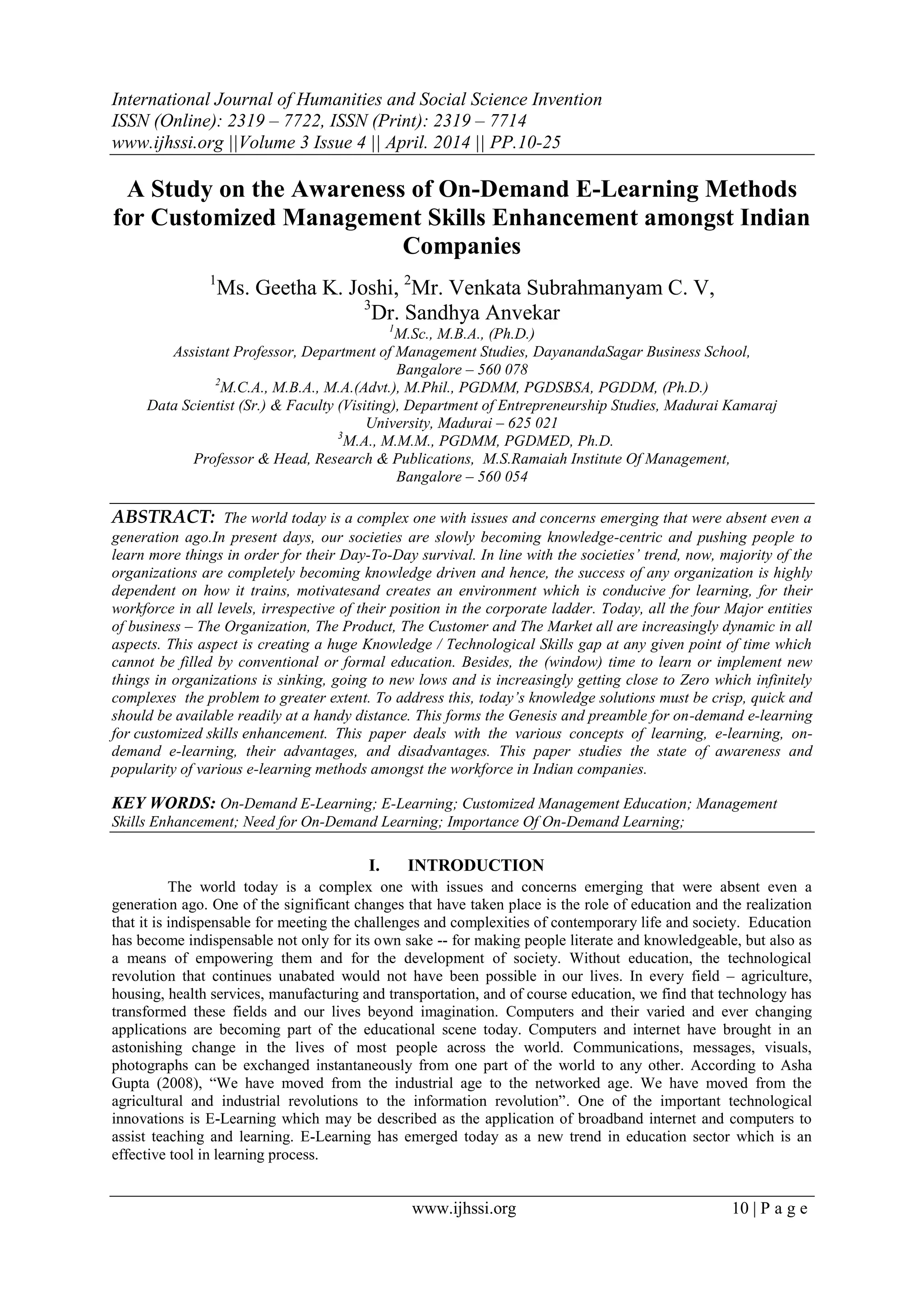
![A Study on the Awareness of On-Demand E-Learning Methods...
www.ijhssi.org 11 | P a g e
II. REVIEW OF LITERATURE
E-LEARNING:
A learner or student who is making use of information technology (IT) through internet is said to be learning
electronically or in other words the computers and internet are contributing to student learning. This, in common parlance, is
termed e-learning. Perhaps the first computer delivered lecture using email, was made by WD Graziadei in 1993. Dr.
Bernard J. Luskin, a distinguished American psychotherapist, is often called an e- learning pioneer, since he has popularized
on line learning both as an educator and an entrepreneur in online learning and new media. E-learning has not only become
widespread in USA, Canada and Europe, it is becoming popular in India at the higher education level. In Asia, also e-
learning is evolving rapidly in several directions as the economies of Japan, China, South Korea and Singapore etc. expand.
E-Learning is referred as the delivery of a learning, training or education program by electronic means. E-learning involves
the use of a computer or electronic device (e.g. a mobile phone) in some way to provide training, educational or learning
material. (Derek Stockley 2003) E-learning can involve a greater variety of equipment than online training or education, for
as the name implies, "online" involves using the Internet or an Intranet. CD-ROM and DVD can be used to provide learning
materials. Distance education provided the base for e-learning's development. E-learning can be "on demand". It overcomes
timing, attendance and travel difficulties. An e-journey is one type of e-learning or online training. Blended learning is e-
learning combined with other training methods. Elliott Masie refers e-learning as “The use of technology to design, deliver,
select, administer, support and extend learning” and Percepsys defines that e-learning is nothing but “Using a technological
means (Internet/Intranet/Extranet) to access and manage learning that supports and enhances the knowledge of an
individual”
ON-DEMAND E-LEARNING (Augmented Learning):
On-Demand E-Learning, also called as Augmented learning, is an on-demand learning technique where the
environment adapts to the learner. By providing remediation on-demand, learners can gain greater understanding of a topic
and stimulate discovery and learning.
Technologies incorporating touchscreens, voices and interaction have demonstrated the educational potential that
scholars, teachers and students are embracing. Instead of focusing on memorization, the learner experiences an adaptive
learning experience based upon the current context. The augmented content can be dynamically tailored to the learner's
natural environment by displaying text, images, video or even playing audio (music or speech). This additional information
is commonly shown in a pop-up window for computer-based environments.
SALIENT FEATURES OF E-LEARNING:
In view of the special needs, abilities and backgrounds of learners, e- learning is becoming more and
more popular. Some of the main features of e-learning are:
Connectivity or networking
Flexibility
Interactivity and collaboration
Virtual Learning Environment (VLE)
TYPES OF E-LEARNING:
Basically there are two types of e-learning – Asynchronous and Synchronous.
ASYNCHRONOUS LEARNING –
1. Self-Paced Courses
Self-paced courses can be delivered in many ways including:
Internet
Intranet or Local Area Networks
CD-ROM or DVD
Self-paced courses usually have these features:
Multimedia: A mix of text, graphics, animation, audio and video to enhance the learning process
Interactivity: An instructional strategy that helps a learner practice what they have learned
Bookmarking: Lets the learner stop the course at any time and restart it from the same point
Tracking: Report the learner's performance within a course to a Learning Management System (LMS)
2. Discussion Groups
SYNCHRONOUS LEARNING –
[1] Virtual Classroom
[2] Audio and Video Conferencing
[3] Chat
[4] Shared Whiteboard
[5] Application Sharing
[6] Instant Messaging
[7] Learning Management Systems (LMS)](https://image.slidesharecdn.com/c0341010025-140512011636-phpapp01/75/C0341010025-2-2048.jpg)
![A Study on the Awareness of On-Demand E-Learning Methods...
www.ijhssi.org 12 | P a g e
[8] Learning Content Management Systems (LCMS)
[9] Knowledge Management System (KMS)
ADVANTAGES OF E-LEARNING:
Is more cost effective.
Saves time without sacrificing quality.
Minimizes travel cost.
Better Suited for Geographically Diverse Employees.
Provides More Consistent Course Delivery.
Offer More Individualized Instruction.
DISADVANTAGES OF ELEARNING:
Technology dependent
Material Incompatibility
Unsuitable for Certain Types of Training
Unsuitable for Certain Types of Learners
Reliant of the Quality of the
Expensive
Reliant on Human Support
Social/economic disadvantage
No Match for Face-to-Face Teaching
Too Reliant on IT Skills
Learners with visual or physical impairments may be disadvantaged.
Inflexible
Pedagogically Unsound
III. RESEARCH METHODOLOGY
A pure scientific methodology & a structured Questionnaire were used and anonline Survey was
conducted in order, to study the state of awareness of various on-demand e-learning methods for the
enhancement of Management skills amongst workforce working in Indian companies. An online survey was
conducted taking 100 Respondentswho were randomly selected from 10 Cities namely Bengaluru, Chennai,
Hyderabad, Thiruvananthapuram, Kochi, Mumbai, Kolkata, Delhi, Pune and Ahmedabad. These are the top 10
cities, contributing to the organized Workforce scenario in India, and hence, is the criterion for selecting these
10 cities. These respondents form a very diverse group differing in their region, state, Government sector,
Private Sector, etc. factors. The reliability (Cronbach‟s Alpha – 0.741) of the instrument is found be in the
accepted region (α> 0.70) for social sciences and is said to be having Good Reliability. The collected Data then
was visualized, analysed and reported in a brief report after a proper & careful process of Data Cleaning.
I. Data Visualization & Analysis
DEMOGRAPHICS:
CHART – 1: Respondents By Region:
N = 1100 Source: Primary Data
50% of the respondents are from Southern region of India, 30% are from Western region and 10% each
from Eastern and Northern regions.](https://image.slidesharecdn.com/c0341010025-140512011636-phpapp01/75/C0341010025-3-2048.jpg)
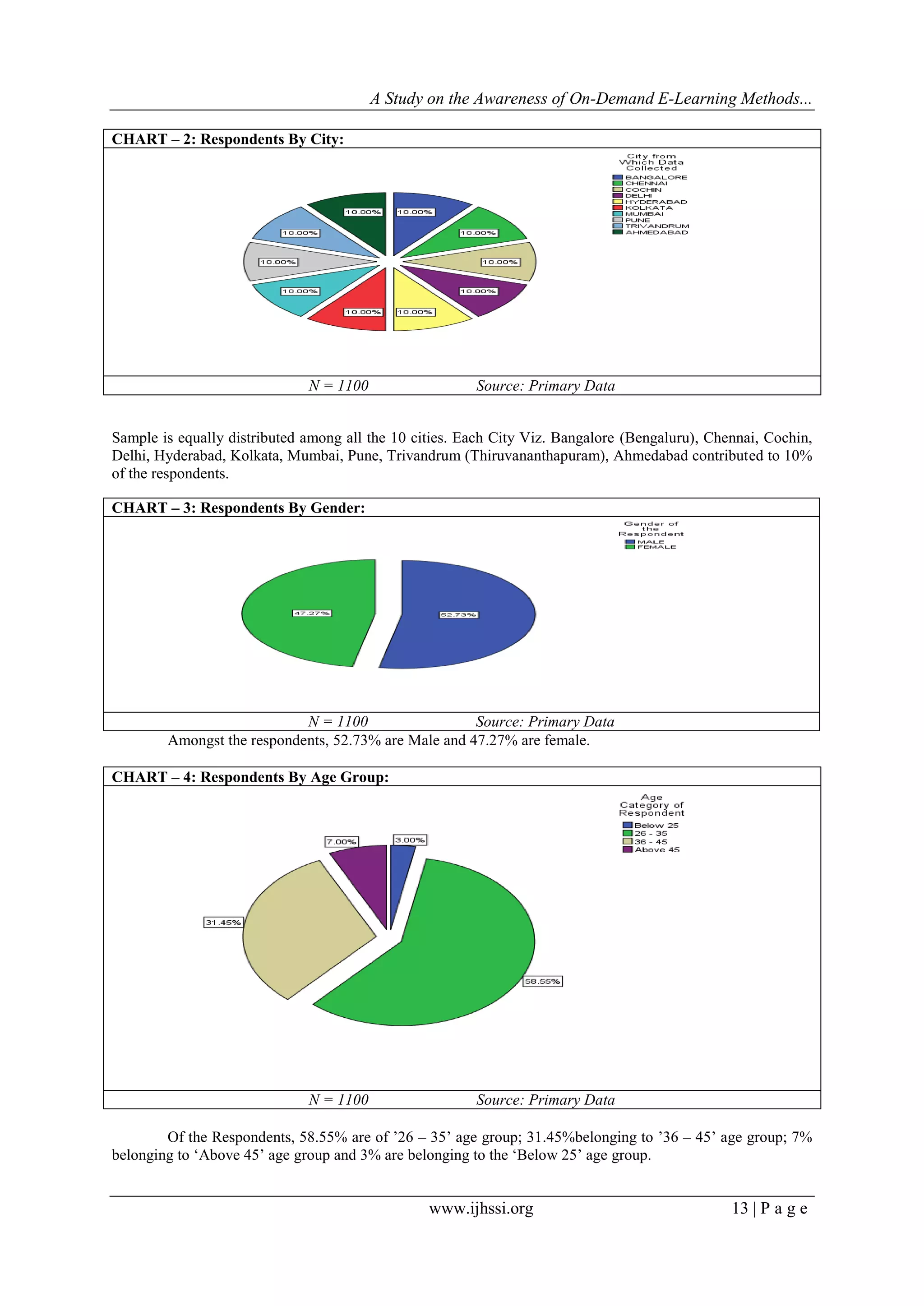
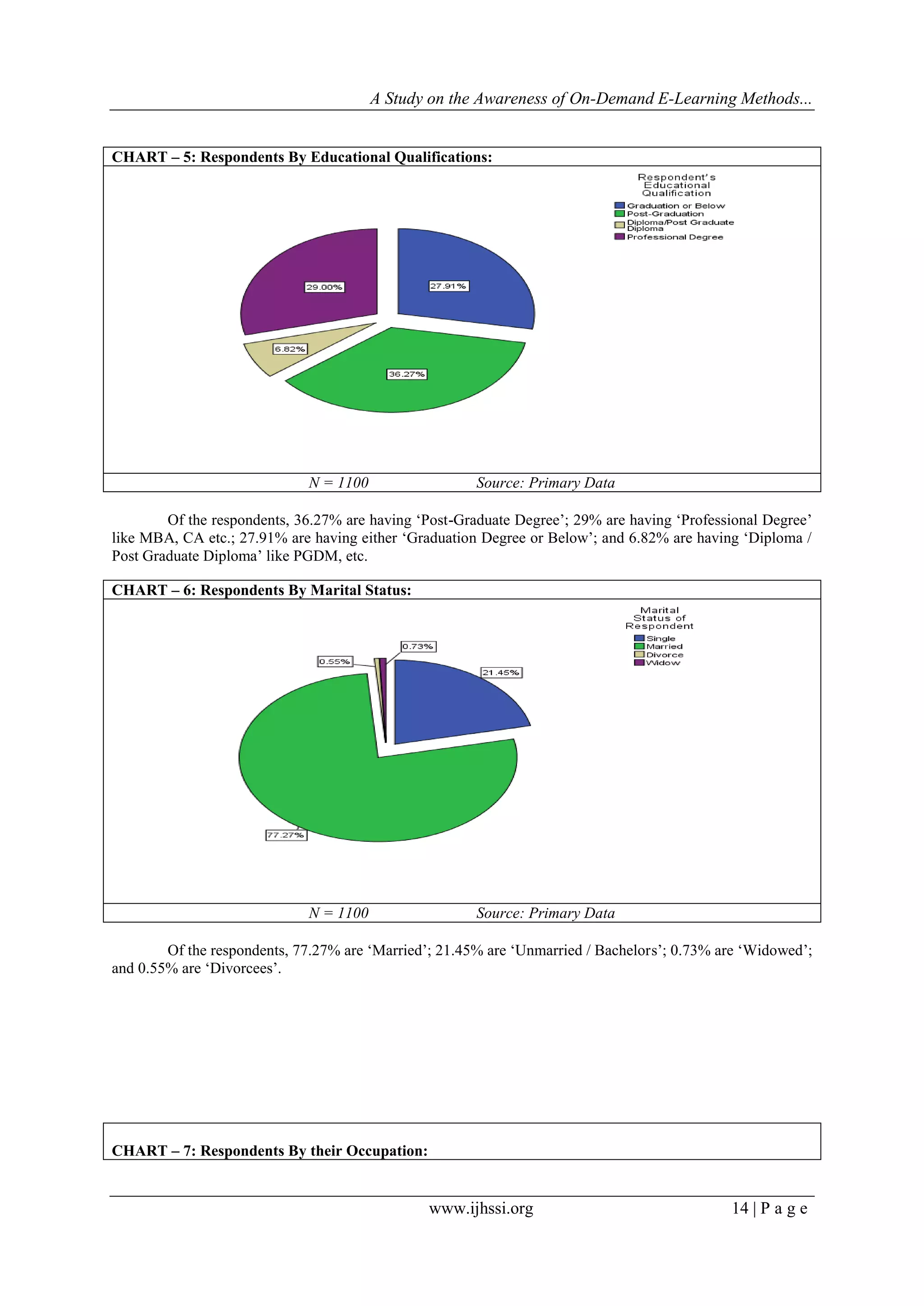
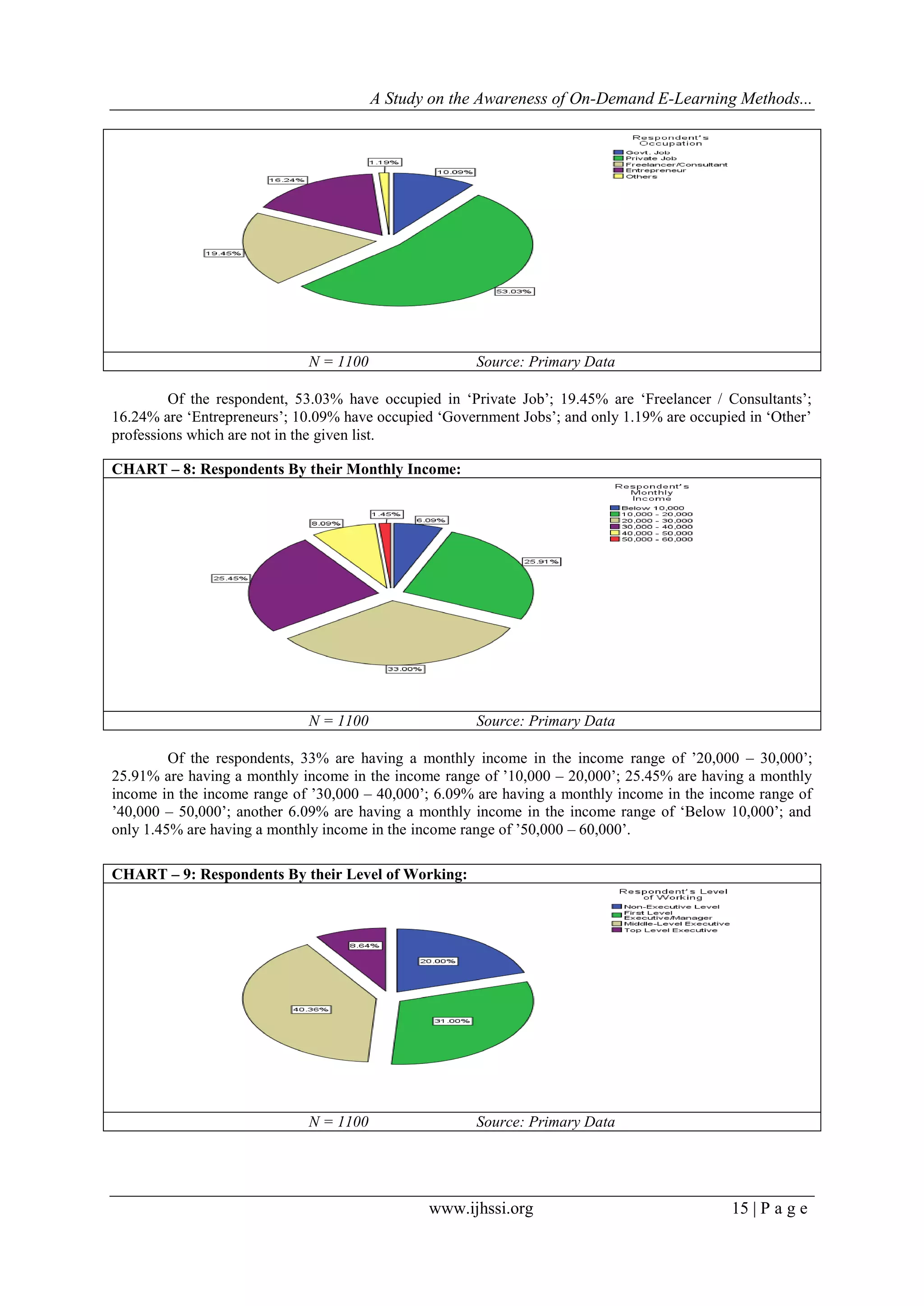
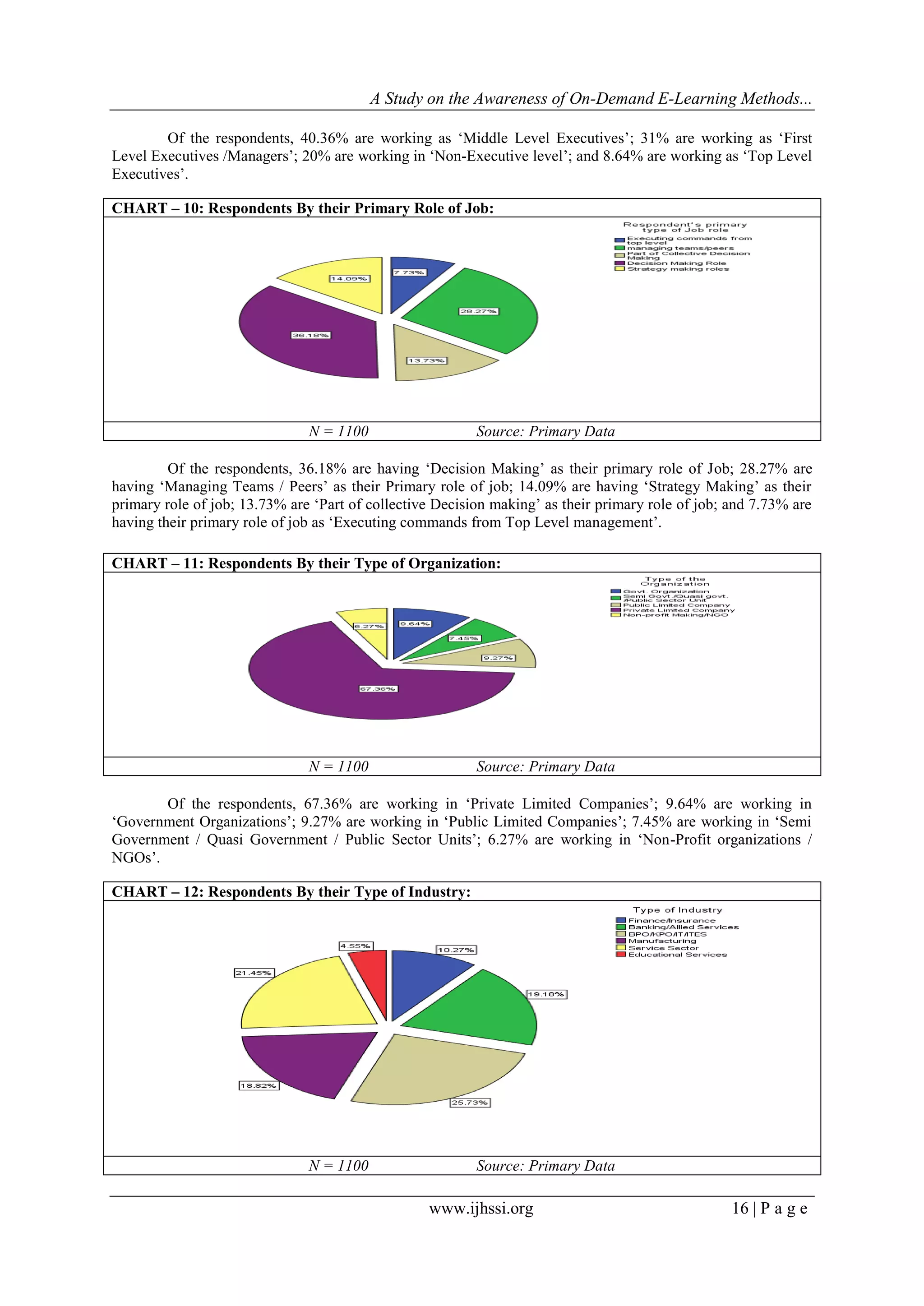
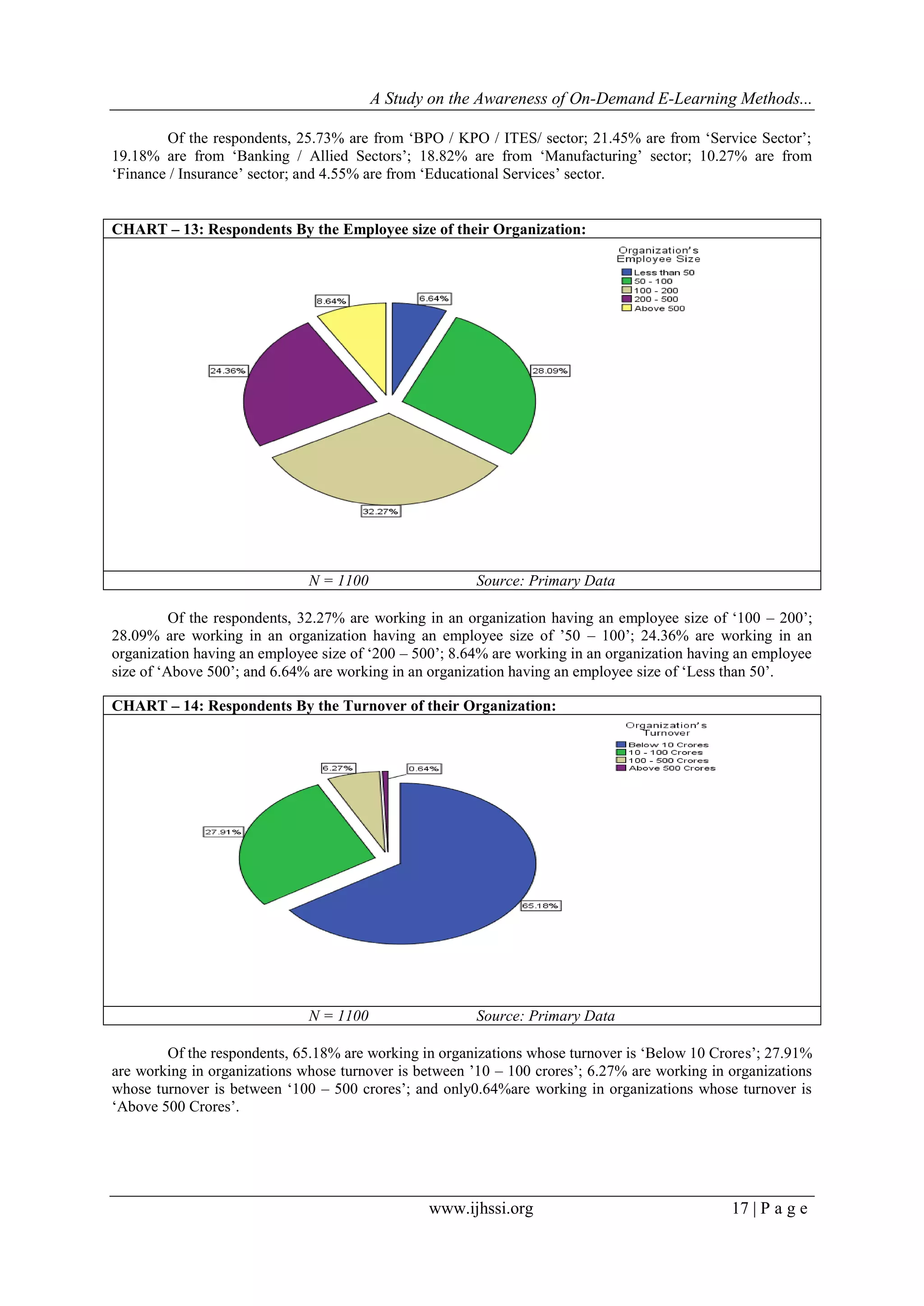
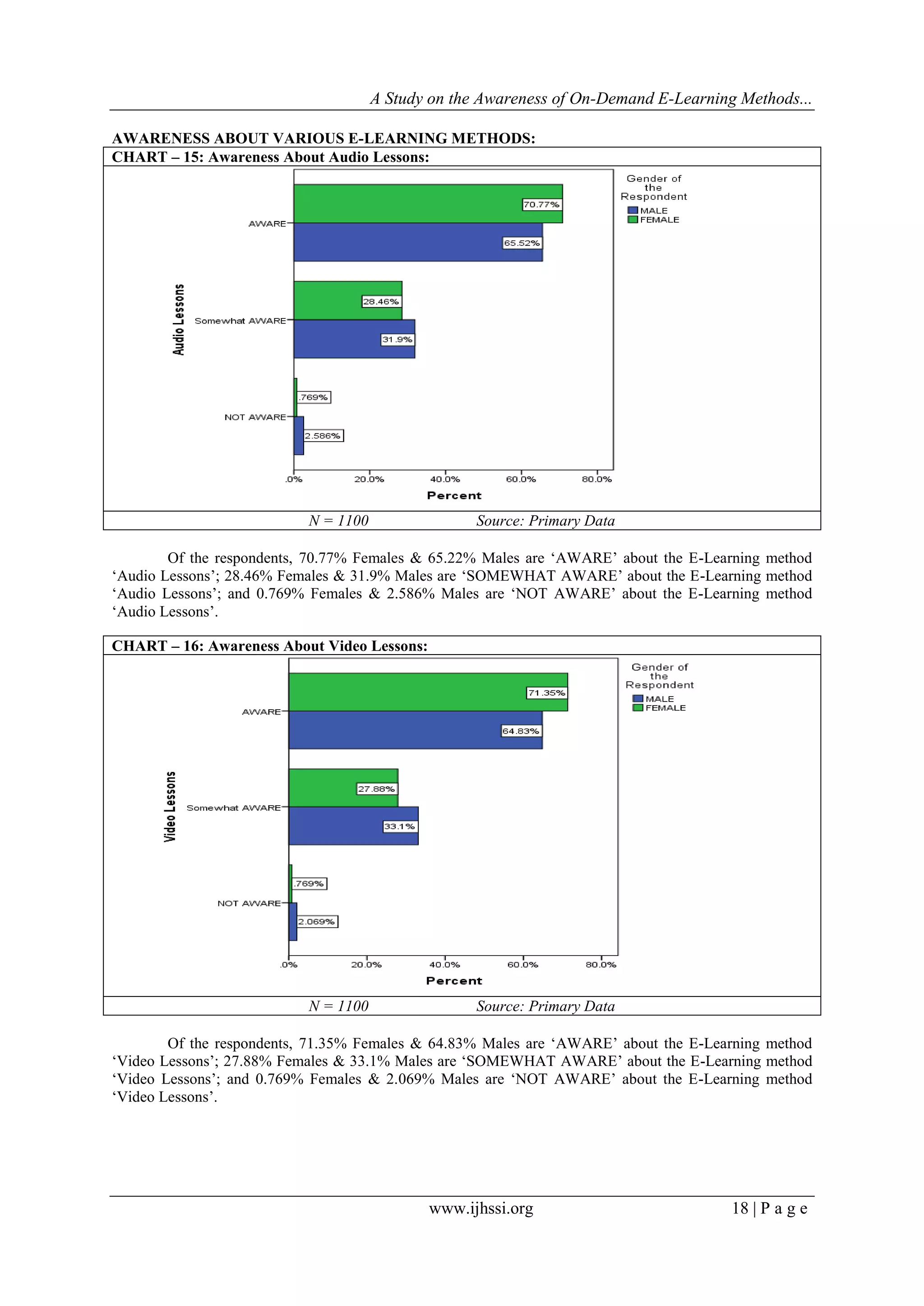
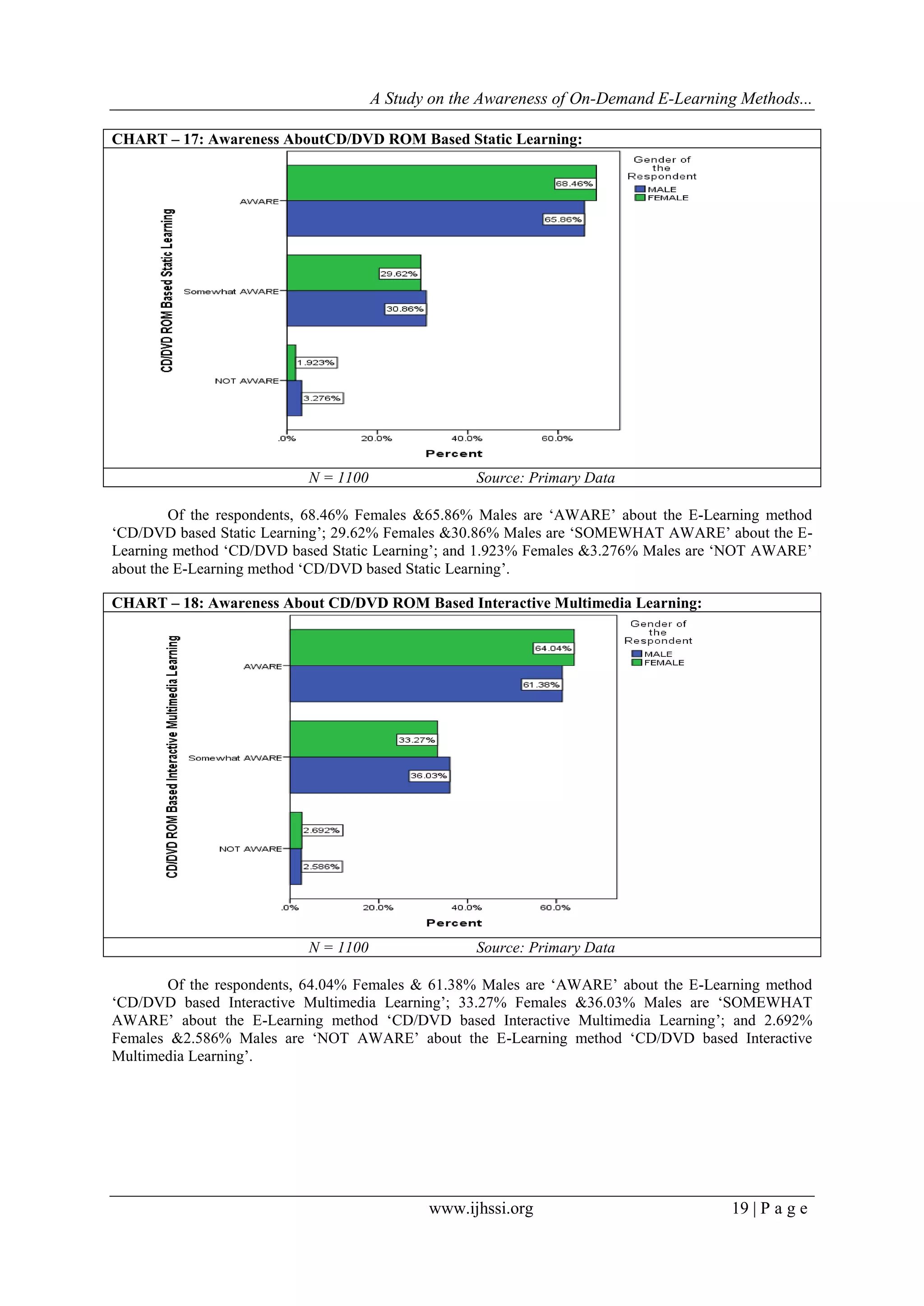
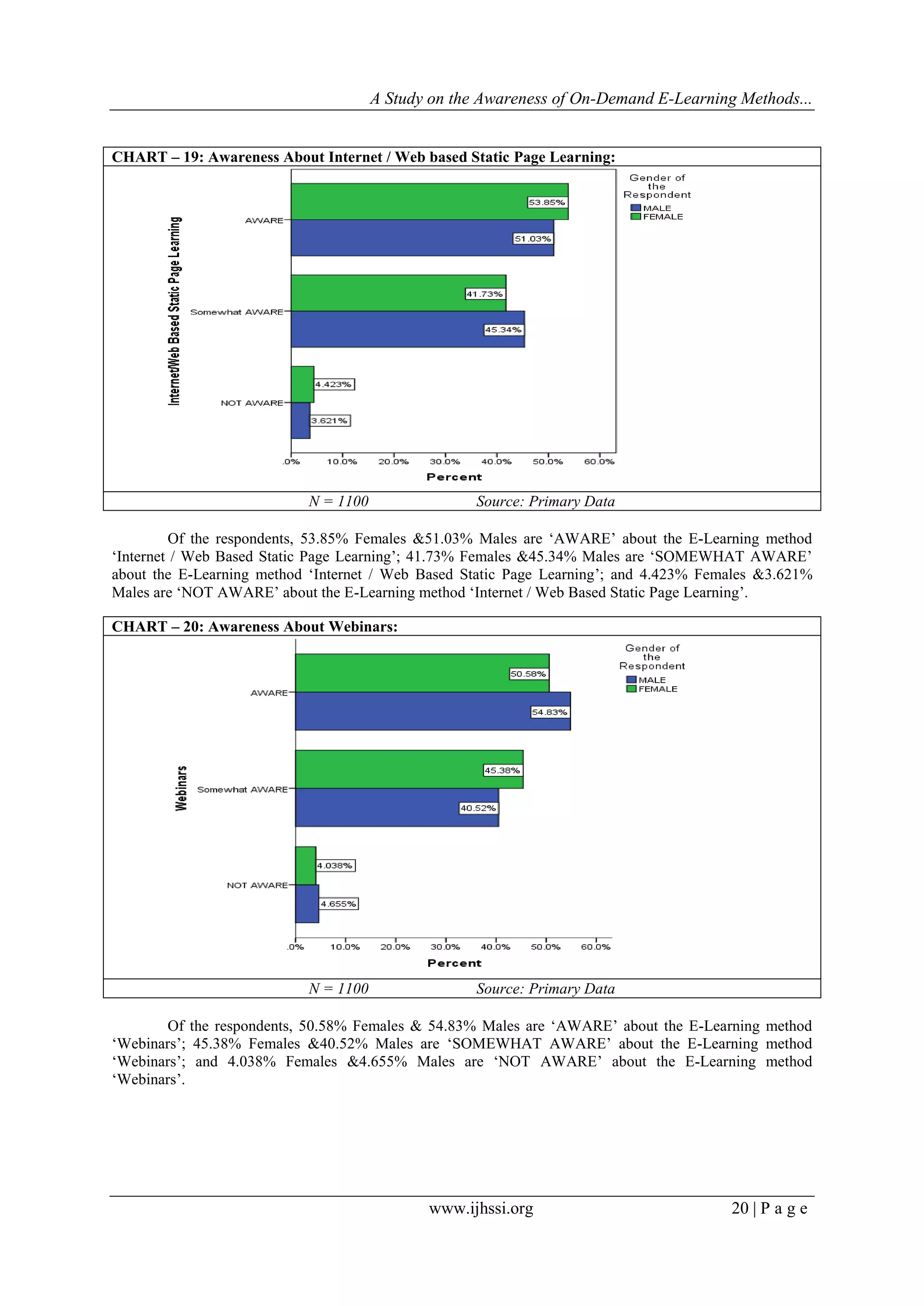
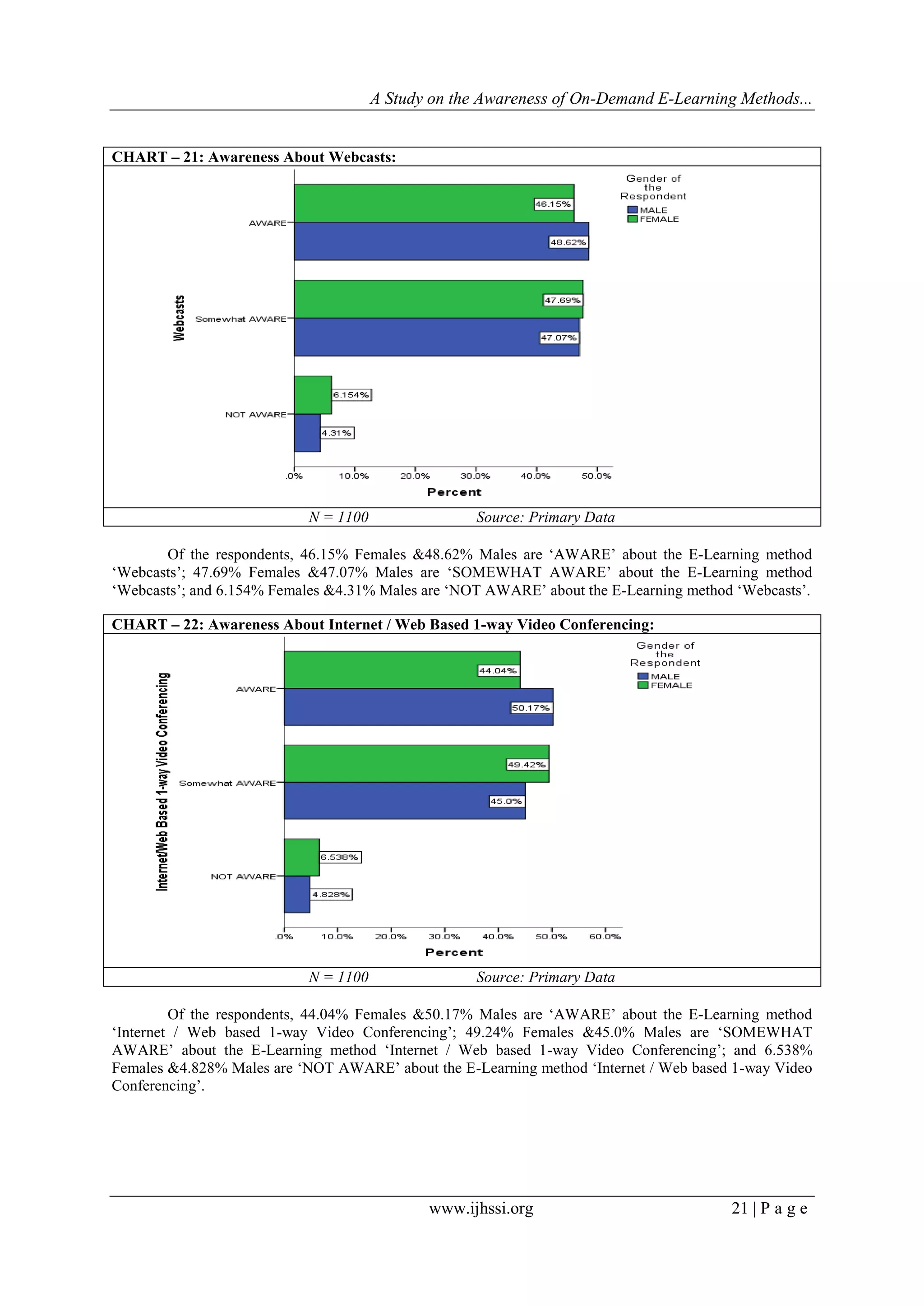
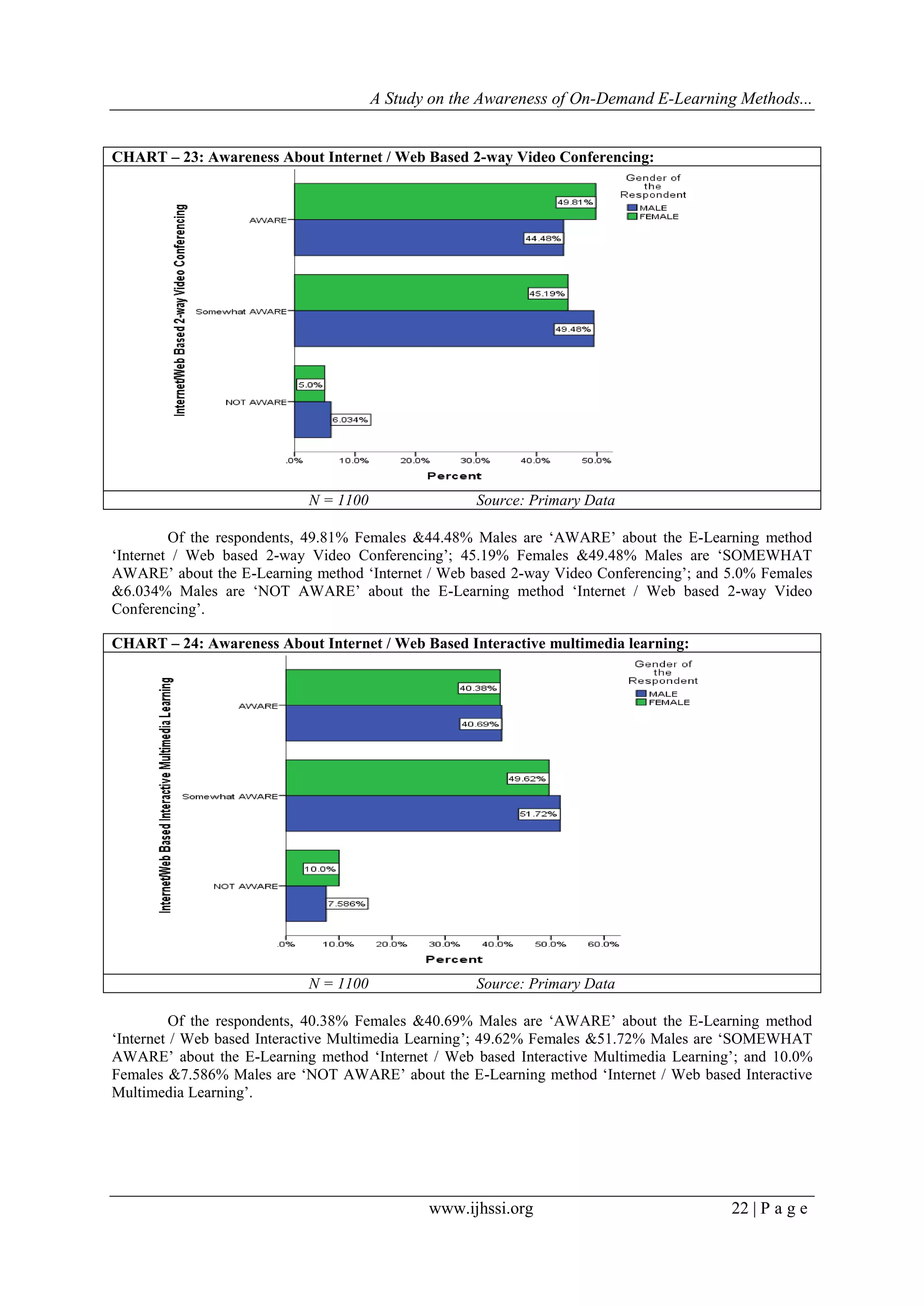

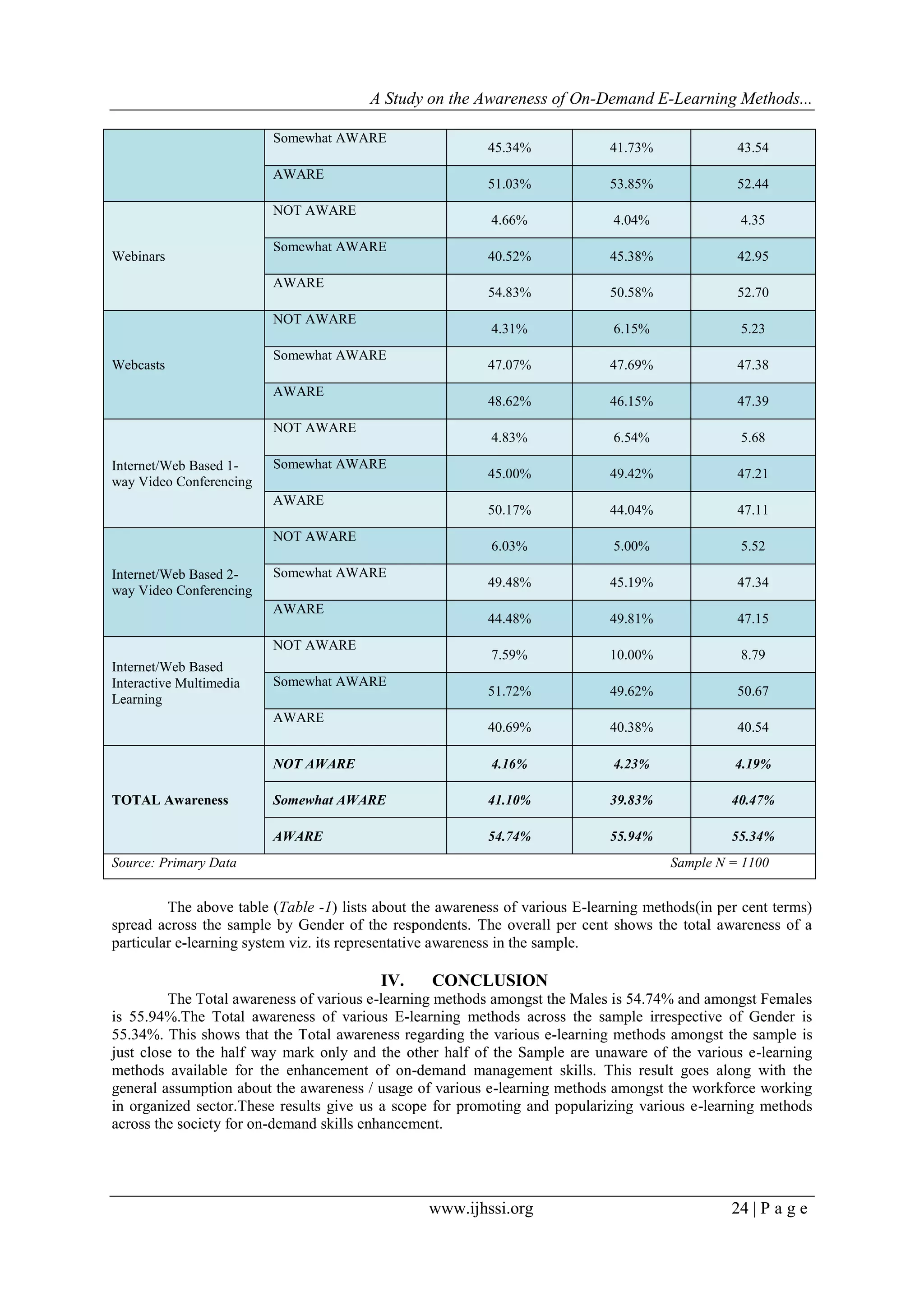
![A Study on the Awareness of On-Demand E-Learning Methods...
www.ijhssi.org 25 | P a g e
REFERENCES:
[1]. Venkata Subrahmanyam C. V., Dr. K. Ravichandran: “Technology &Online Distance Mode of Learning”. International Journal
of Humanities and Social Science Invention (IJHSSI) ISSN (Online): 2319 – 7722, ISSN (Print): 2319 – 7714 Volume 2 Issue 1
January-2013PP 05-13
[2]. Geetha K. Joshi, Venkata Subrahmanyam C. V., Dr. SandhyaAnvekar. “The Need and Importance of On-Demand E-Learning for
Customized Management Skills Enhancement”. IOSR Journal Of Humanities And Social Science (IOSR-JHSS) e-ISSN: 2279-
0837, p-ISSN: 2279-0845.Volume X, Issue X, Ver. I (Feb. 2014), PP 01-00.
[3]. Geetha K. Joshi, Venkata Subrahmanyam C. V., Dr. SandhyaAnvekar. “The Need and Importance of On-Demand E-Learning for
Customized Management Skills Enhancement”. Quest Journals - Journal of Research in Humanities and Social Science.
ISSN(Online) : 2321-9467. Volume 2, Issue 2 (2014) PP: 33-41
[4]. Daniel L. Schacter, Daniel T. Gilbert, Daniel M. Wegner (2009, 2011). Psychology, 2nd edition. Worth Publishers. p. 264. ISBN
978-1-4292-3719-2
[5]. Jump up ^ Jungle Gyms: The Evolution of Animal Play
[6]. "Think "Exciting": E-Learning and the Big "E"" Retrieved, 7 December 2012.
[7]. Jump up ^ Eric Parks. "What's the "e" in e-Learning?" Askinternational.com. Retrieved 2013-10-22.
[8]. Kurbel, Karl: Virtuality on the Students' and on the Teachers' sides: A Multimedia and Internet based International Master
Program; ICEF Berlin GmbH (Eds.), Proceedings on the 7th International Conference on Technology Supported Learning and
Training – Online Educa; Berlin, Germany; November 2001, pp. 133–136
[9]. Gupta Asha. (2008), Education in the 21st Century : Looking Beyond University, Shipra Publications, Delhi.
[10]. Van Dusen, G.C. (2001), “Digital dilemma: Issues of access, cost, and quality in media-enhanced and distance education”,
Jossey-Bass Inc, California
[11]. Bascelli, D. (2005). “Making Work Real: Building Virtual Learning Communities”. In P. Kommers& G. Richards (Eds.),
Proceedings of World Conference on Educational Multimedia, Hypermedia and Telecommunications (EDMEDIA) Montreal,
Canada June 27.
[12]. Ravi P Bhatia, “Features and Effectiveness of E-learning Tools”, Global Journal of Business Management and Information
Technology, Volume 1, Number 1 (2011), pp. 1-7 © Research India Publications
[13]. http://en.wikipedia.org/wiki/On-demand_learning
[14]. http://www.e-learningconsulting.com/consulting/what/learning-management.html
[15]. http://www.aadm.com/moreinfo.htm
[16]. http://www.edurite.com/blog/the-importance-of-elearning/1071/#
[17]. http://www.e-learningconsulting.com/consulting/what/asynchronous.html
[18]. http://www.e-learningconsulting.com/consulting/what/e-learning.html
[19]. http://www.e-learningconsulting.com/consulting/what/synchronous.html
[20]. http://tecfa.unige.ch/tecfa/publicat/peraya-papers/ocde/ocde14.htm
[21]. http://www.publishyourarticles.net/knowledge-hub/education/what-are-the-factors-that-affect-learning.html
[22]. http://blc.uc.iupui.edu/AcademicEnrichment/StudySkills/LearningStyles/3LearningStyles.aspx
[23]. http://en.wikipedia.org/wiki/Learning
[24]. http://www.businessdictionary.com/definition/learning.html#ixzz2qjxGP89B](https://image.slidesharecdn.com/c0341010025-140512011636-phpapp01/75/C0341010025-16-2048.jpg)